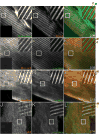Different obscurin isoforms localize to distinct sites at sarcomeres
- PMID: 17382936
- PMCID: PMC1899168
- DOI: 10.1016/j.febslet.2007.03.011
Different obscurin isoforms localize to distinct sites at sarcomeres
Abstract
We used four antibodies to regions of obscurin isoforms A and B, encoded by the obscurin gene, to investigate the location of these proteins in skeletal myofibers at resting and stretched lengths. Obscurin A ( approximately 800 kDa) which was recognized by antibodies generated to the N-terminal, Rho-GEF, and the non-modular C-terminal domain that lacks the kinase-like domains, localizes at the level of the M-band. Obscurin B ( approximately 900 kDa) which has the N-terminal, Rho-GEF, and the C-terminal kinase-like domains, localizes at the level of the A/I junction. Additional isoforms, which lack one or more of these epitopes, are present at the Z-disk and Z/I junction.
Figures





References
-
- Russell MW, Raeker MO, Korytkowski KA, Sonneman KJ. Identification, tissue expression and chromosomal localization of human Obscurin-MLCK, a member of the titin and Dbl families of myosin light chain kinases. Gene. 2002;282:237–246. - PubMed
-
- Bang ML, Centner T, Fornoff F, Geach AJ, Gotthardt M, McNabb M, Witt CC, Labeit D, Gregorio CC, Granzier H, Labeit S. The complete gene sequence of titin, expression of an unusual approximately 700-kDa titin isoform, and its interaction with obscurin identify a novel Z-line to I-band linking system. Circ Res. 2001;89:1065–1072. - PubMed
-
- Fukuzawa A, Idowu S, Gautel M. Complete human gene structure of obscurin: implications for isoform generation by differential splicing. J Muscle Res Cell Motil. 2006 - PubMed
-
- Kontrogianni-Konstantopoulos A, Bloch RJ. Obscurin: a multitasking muscle giant. J Muscle Res Cell Motil. 2006 - PubMed
Publication types
MeSH terms
Substances
Grants and funding
LinkOut - more resources
Full Text Sources
Molecular Biology Databases

